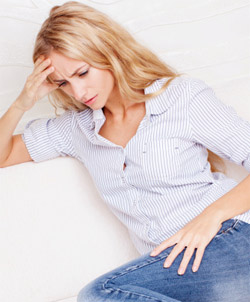
A study has proved that young female runners may have more PMS symptoms. Adolescent runners may be more likely to get premenstrual syndrome (PMS) than those who don’t exercise, particularly if they are older when they first get their periods, a small study suggests. The findings contradict prevailing wisdom about PMS that recommends exercise to ease symptoms such as fatigue, muscle aches, bloating and mood swings. With just 125 participants, though, the study is too small to be the final word on PMS and athletes, write the researchers.
For example, there may be something about being a competitive athlete that allows young women to be more aware of changes in their body, making the athletes more likely to notice PMS symptoms,” said Susan Girdler, a psychiatry professor at the University of North Carolina at Chapel Hill. She wasnt involved in the study. Periods, also known as menstruation, occur when the body sheds the lining of the uterus. The process causes women to bleed from the vagina. Usually, symptoms of PMS occur one to two weeks before menstruation, according to the U.S. Department of Health and Human Services. The study compared symptoms of PMS, and a more severe form known as premenstrual dysphoric disorder (PMDD), in 75 middle- and long-distance runners and 50 healthy young women who didn’t exercise. Participants were between the ages of 16 and 22.
Most of the athletes had trained for at least two years and exercised for two hours a day, or around 12 hours a week. There wasn’t a big difference between the runners and the non-exercisers in the age at which they started menstruating, but the runners had significantly heavier bleeding and longer intervals between periods than non-athletes.
Also, 49 percent of runners had PMS, compared with 32 percent of the non-athletes. For the athletes, being older, and having more years of training and a more intense workout routine increased the likelihood of PMS. The runners also had more instances of PMDD, but that finding may be due to chance. Members of the Polish research team, who published the study in the Journal of Pediatric and Adolescent Gynecology, didn’t respond to emails seeking comment.
 It’s possible that the athletes might report more signs of PMS because many of the symptoms – such as muscle aches, headaches and fatigue – can also occur with intense exercise, said Dr. Ruta Nonacs, a psychiatrist at the Center for Womens Mental Health at Massachusetts General Hospital in Boston. The findings contradict common perceptions of exercises effect on PMS, said Nonacs, who wasn’t involved in the study.
It’s possible that the athletes might report more signs of PMS because many of the symptoms – such as muscle aches, headaches and fatigue – can also occur with intense exercise, said Dr. Ruta Nonacs, a psychiatrist at the Center for Womens Mental Health at Massachusetts General Hospital in Boston. The findings contradict common perceptions of exercises effect on PMS, said Nonacs, who wasn’t involved in the study.
She added that the focus on PMS in female athletes overlooks a much more serious medical issue, which is that often, female athletes don’t ovulate and the process of ovulation is linked to many PMS symptoms. “From a medical perspective, it’s the lack of period that’s much more concerning because it puts them at risk for bone metabolic issues if it’s prolonged,” she said.
Particularly with teen athletes, it’s important to watch for signs that they are training excessively, added Girdler, who also found lack of menstruation to be the larger health concern for young women than PMS. “At this age you want to watch for skipped menstrual cycles, substantial weight loss, and any evidence that the workouts have become obsessive and go beyond just meeting the training goals of a particular team or exercise program,” Girdler said. “The level of exercise in this study doesn’t appear to be obsessive.”